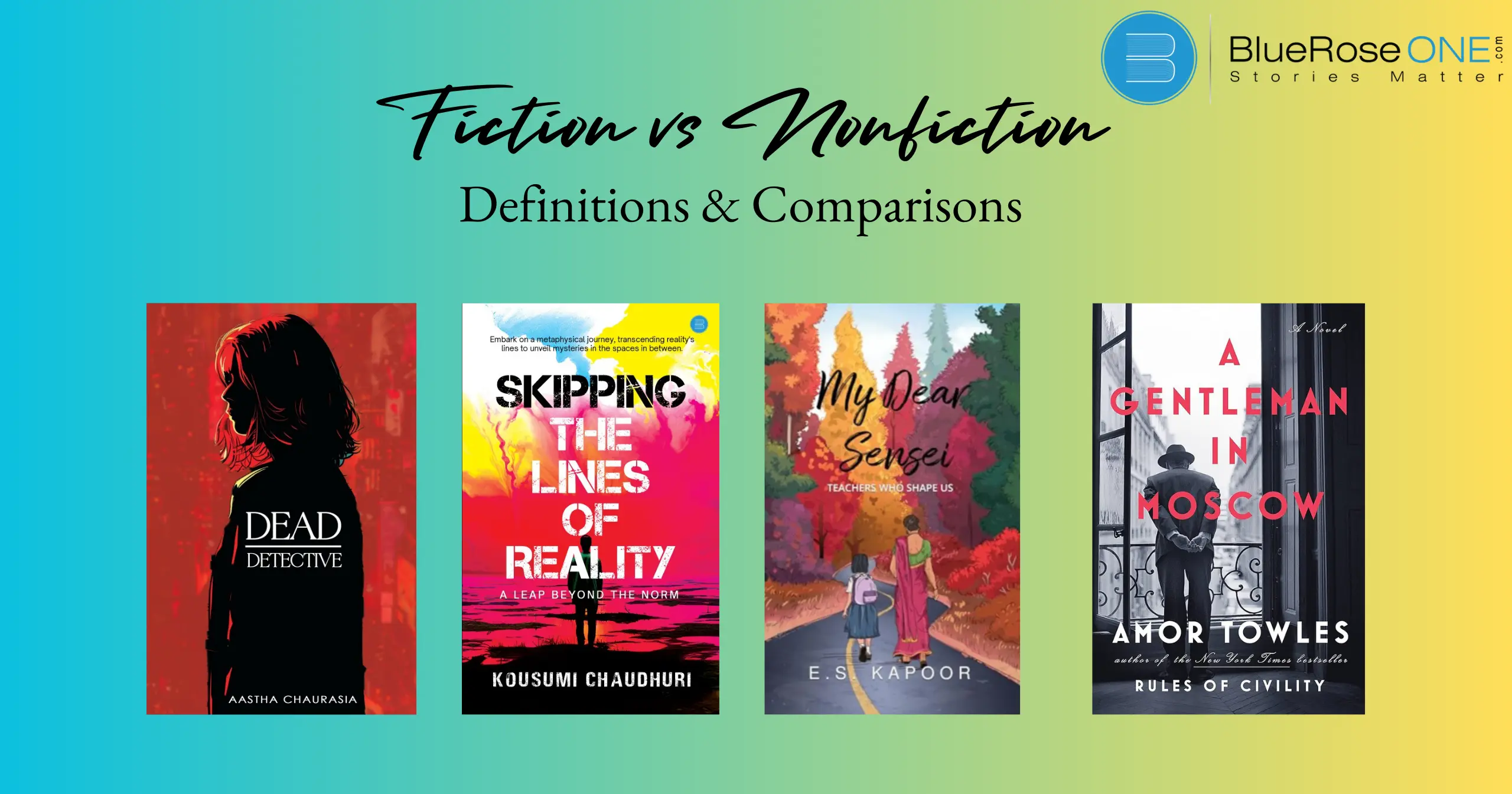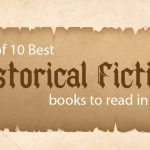Both readers and authors need to be aware of the distinctions between fiction and nonfiction. These two overarching literary genres have different functions and affect our interactions with information and tales.
Understanding the differences between these genres can improve your reading experience and direct your writing efforts, whether you’re writing for readers interested in factual insights or diving into a fanciful realm.
What is Fiction?
Fiction refers to literary works that are created from the imagination rather than based on real events. This genre encompasses novels, short stories, and novellas that feature made-up characters, settings, and plots.
Characteristics of Fiction:
Imaginary Content: One of the main things that distinguishes fiction from nonfiction is its imaginative quality. Fiction authors create imaginary worlds, people, and events with the intention of amusing, stimulating the imagination, or exploring possible outcomes.
This imaginative component enables imaginative storytelling and a variety of plot twists that are not limited to following historical accuracy.
Writers can enthrall readers and provide them with a distinctive getaway from reality by creating captivating and imaginary components.
Creative Freedom: One key characteristic of fiction is its creative freedom. Unlike nonfiction, which is based on factual information and real events, fiction allows writers to explore imaginary worlds, create unique characters, and invent scenarios without being bound by reality.
This freedom lets authors craft stories that can transcend ordinary experiences, offering readers an escape into new and inventive realms. The creativity in fiction not only engages the imagination but also provides a deeper connection to universal themes and emotions.
Varied Genres: Fiction comes in a variety of genres that showcase the variety of experiences and storytelling possibilities available.
Every genre adds a distinct flavor to fiction, from the enchanting worlds of fantasy to the thrilling turns of thrillers. These genres give writers the freedom to engage readers of various interests and explore a variety of issues.
The emotional journey of romance literature or the historical depth of historical fiction—all of fiction’s genres enhance the reading experience and demonstrate the adaptability of creative storytelling.
You may also read: A Complete List of Anuja Chauhan Books
Examples of Fiction Genres
- Fantasy: Tales set in magical worlds, such as J.K. Rowling’s “Harry Potter” series.
- Science Fiction: Stories that explore futuristic concepts, like Isaac Asimov’s “Foundation” series.
- Mystery: Works centered around solving crimes or puzzles, such as Arthur Conan Doyle’s “Sherlock Holmes” series.
- Romance: Narratives focused on love and relationships, like Jane Austen’s “Pride and Prejudice.”
What is Nonfiction?
Nonfiction is a genre of writing that focuses on presenting factual information and real events. Unlike fiction, which creates imaginative stories, nonfiction aims to inform, educate, or document reality.
This genre includes a variety of formats such as biographies, self-help books, and history texts. Nonfiction works are grounded in truth and often involve research or personal experiences. By providing accurate details and analysis, nonfiction helps readers understand and engage with the real world.
Characteristics of Nonfiction
Factual Basis: The factual foundation of nonfiction is one of its main characteristics. Writing that is nonfiction is based on facts, figures, and actual occurrences with the goal of delivering accurate and trustworthy information.
Nonfiction is concerned with providing information that reflects reality and can be supported by evidence, as opposed to fiction, which tells stories based solely on the author’s imagination.
Nonfiction is an invaluable tool for knowledge acquisition and factual insight because of its factual basis, which fosters reader trust and comprehension.
Objective and Informative: Nonfiction writing is objective and educational at the same time. This indicates that the goal of nonfiction is to convey facts and information free from prejudice or personal opinion.
The intention is to enlighten and educate readers about actual events, persons, or ideas by giving them clear, accurate, and trustworthy content.
Nonfiction is concerned with factual accuracy and clarity, making sure readers receive an accurate portrayal of the subject matter, in contrast to fiction, which relies on imagination and storytelling.
Structured Presentation: The systematic presentation of nonfiction is one of its main traits. In nonfiction writing, facts and ideas are arranged logically and clearly so that the reader may understand them with ease.
To simplify complicated subjects, this format frequently uses headings, subheadings, bullet points, and numbered lists. Nonfiction is essential for setting itself apart from fiction since it provides information in a methodical manner that makes it easier for readers to follow the story and understand key aspects.
Examples of Nonfiction Genres
- Biography and Autobiography: Detailed accounts of individuals’ lives, such as Nelson Mandela’s “Long Walk to Freedom.”
- Self-Help: Books offering advice and strategies for personal improvement, like Stephen Covey’s “The 7 Habits of Highly Effective People.”
- Historical Writing: Accounts of past events, such as Doris Kearns Goodwin’s “Team of Rivals.”
- Essays and Journalism: Articles and essays that discuss various topics, like Malcolm Gladwell’s “Outliers.”
Key Differences Between Fiction and Nonfiction
The distinction between fiction and nonfiction lies primarily in the basis of their content and their intended purposes.
Basis of Content:
- Fiction: Centers around imaginary events and characters.
- Nonfiction: Based on real-life facts and information.
Purpose and Intent:
- Fiction: Aims to entertain, provoke thought, and explore human experiences through imaginative scenarios.
- Nonfiction: Seeks to inform, educate, or persuade by presenting factual evidence and logical arguments.
Structure and Style:
- Fiction: Employs narrative techniques, character development, and plot construction.
- Nonfiction: Focuses on factual presentation, logical organization, and evidence-based arguments.
Purpose of Fiction
Fiction serves several purposes beyond mere entertainment. It provides readers with an escape from reality, a way to explore complex themes, and an opportunity to engage emotionally with characters and stories.
Entertainment and Imagination: Fiction serves a crucial role in entertainment and imagination. It allows readers to escape reality and explore new worlds, ideas, and experiences that they might not encounter in their everyday lives.
Through imaginative storytelling, fiction engages the mind and emotions, providing enjoyment and a deeper understanding of different perspectives.
This creative process stimulates the imagination and offers a form of relaxation and pleasure, showing why fiction is such an essential and cherished part of literature.
Exploration of Themes and Human Nature: Exploring ideas and human nature is made possible in large part by fiction. Fiction, unlike nonfiction, frequently permits readers to dive into difficult concepts and feelings through the creation of fictional worlds and characters.
Fiction explores morals, societal issues, and human behavior via narrative, providing insights into our own selves and the societies in which we live.
Fiction is an effective instrument for investigating and challenging human nature because of this creative approach, which also encourages us to consider our own experiences and comprehend many points of view.
Emotional Connection: Developing an emotional bond with readers is one of fiction’s main goals. Fiction writers can create stories that make readers feel emotions through characters and circumstances, such as joy, sorrow, or fear.
Because of this emotional connection, readers are able to relate to the story on a personal level and are given the opportunity to consider other viewpoints and comprehend nuanced emotions.
Essentially, fiction offers a special channel for relating to our emotions as well as those of others.
Purpose of Nonfiction
Nonfiction’s primary goal is to convey factual information and provide insights into real-world topics. It plays a crucial role in education and personal growth.
Informing and Educating: The main goals of nonfiction are to inform and educate the reader. Nonfiction seeks to provide factual data and real-life observations, in contrast to fiction, which is more concerned with creative storytelling.
Readers can learn about a variety of topics from historical events to scientific discoveries with the aid of this genre. Nonfiction is a great way to learn and comprehend the world because it offers trustworthy and truthful information.
Nonfiction writing, whether it’s a factual report or a how-to manual, aims to simply and efficiently enlighten and educate its readers.
Presenting Factual Information: Giving readers accurate information is the main goal of nonfiction. Nonfiction seeks to enlighten, educate, or offer insights based on real occurrences and genuine data, in contrast to fiction, which is more concerned with creative storytelling and made-up characters.
Nonfiction, whether it be in the form of history texts, biographies, or self-help books, is based in reality and seeks to inform readers about facts and true stories. This contrast aids readers in comprehending and differentiating between the fictional and factual realms of nonfiction.
Persuasion and Argumentation: In nonfiction, persuasion and argumentation serve to convince readers of a particular viewpoint or to persuade them to take action. Unlike fiction, which primarily aims to entertain and engage through storytelling, nonfiction focuses on presenting facts, evidence, and logical reasoning to make a case.
Persuasion in nonfiction involves using emotional appeal or credibility to influence readers, while argumentation relies on structured arguments and evidence to support claims.
Understanding these elements helps readers differentiate between the informative nature of nonfiction and the imaginative elements of fiction.
Structure and Style in Fiction
Fiction employs a variety of narrative techniques to engage readers and build immersive worlds.
Narrative Techniques: Narrative strategies in fiction influence both the telling and the reading of a story. First-person narrative techniques offer a firsthand perspective that puts readers in the character’s head and allows them to empathize with their feelings.
Third-person narration, on the other hand, provides a deeper understanding of the narrative by presenting the perspectives of several individuals.
These narrative techniques have an impact on the flow and interest of literature, creating immersive and distinctive worlds that readers can explore.
Character Development: Character development is essential to writing convincing and captivating fiction. It entails creating characters that develop and shift as the story progresses.
When characters are well-developed, readers are able to emotionally identify with them, which makes their struggles and experiences more interesting. The histories, motivations, and internal struggles of characters are frequently revealed during this process.
By concentrating on character development, authors make sure that the fictitious characters they create are vivid and enduring, which raises the standard of their writing in general.
Plot Construction: Plot development is essential to compelling narrative in fiction. It entails arranging things in a logical order that heightens tension and keeps readers interested.
A plot that is well-written usually has a distinct beginning, middle, and end. This structure aids in the efficient development of ideas and personalities.
Authors may craft gripping stories that captivate readers’ attention and offer satisfying conclusions by meticulously crafting their plots. Composing fiction with impact requires an understanding of story construction.
Structure and Style in Nonfiction
Nonfiction writing is characterized by its structured approach to presenting information.
Factual Presentation: In non-fiction writing, the presenting of facts is essential. It entails disseminating knowledge founded on actual occurrences, facts, or proof.
Non-fiction necessitates accuracy and clarity, in contrast to fiction, which places more emphasis on storytelling and imagination. Writers need to ensure that their content is trustworthy and educational by presenting facts in an organized way.
Effective non-fiction writing requires factual presentation because it makes the content easier for readers to understand and trust.
Logical Organization: For non-fiction to be understood and clear, it must be logically organized. It entails putting the facts in a logical order that makes it easier for readers to follow the story or argument.
Non-fiction uses distinct parts and subheadings to present facts and ideas in an organized manner, in contrast to fiction, where the plot dictates the structure.
This method makes sure that difficult concepts are divided into digestible chunks, which helps readers comprehend and remember the material.
Use of Evidence and Research: For non-fiction writing to be accurate and credible, research and evidence must be used. Non-fiction depends on factual facts to enlighten and persuade readers, in contrast to fiction, which frequently emphasizes imaginative storytelling.
Writers back up their assertions with facts, figures, and citations from reliable sources. In addition to supporting the arguments, this evidence enables readers to independently check the facts.
When research is properly mentioned, non-fiction writings become more credible and stand out from fictional storylines that value creativity above factual truth.
Genres of Fiction
Fiction spans a wide range of genres, each offering unique experiences and storytelling techniques.
- Fantasy: Features magical elements and otherworldly settings.
- Science Fiction: Explores futuristic technology and scientific advancements.
- Mystery and Thriller: Centers on solving crimes or uncovering secrets.
- Romance: Focuses on romantic relationships and emotional journeys.
Genres of Nonfiction
Nonfiction genres cover diverse topics and purposes, from personal stories to academic research.
- Biography and Autobiography: Chronicles individuals’ lives and experiences.
- Self-Help and Personal Development: Provides strategies for personal growth and problem-solving.
- Historical and Scientific Writing: Offers insights into past events and scientific discoveries.
- Essays and Journalism: Discusses various topics, often with a focus on current events or personal reflections.
How to Choose Between Fiction and Nonfiction
Selecting between fiction and nonfiction depends on your goals, interests, and the audience you aim to reach.
Understanding Your Goals: When deciding between fiction and nonfiction, it’s important to consider your goals. Fiction allows you to create imaginative worlds and characters, making it ideal if you want to entertain or explore creative ideas.
Nonfiction, on the other hand, focuses on real-life facts and information, perfect for educating or informing your readers. Reflect on whether your aim is to captivate with stories and creativity, or to provide factual insights and real experiences. Understanding these goals will help you choose the right genre for your writing.
Audience Considerations: When choosing between fiction and nonfiction, consider your audience’s interests and needs. Fiction often appeals to readers looking for imaginative stories and emotional engagement, offering an escape from reality.
Nonfiction, on the other hand, attracts those seeking factual information, real-life insights, or practical knowledge. Understanding your audience helps ensure your writing meets their expectations,
whether it’s crafting compelling fictional worlds or delivering accurate, informative content. Tailoring your choice to what resonates with your readers enhances the effectiveness of your work.
Subject Matter and Interest: When choosing between fiction and nonfiction, consider your subject matter and interest. Fiction, with its made-up stories and imaginative worlds, is great for exploring creative ideas and escaping reality. Nonfiction, on the other hand, provides factual information and real-life accounts.
If you’re passionate about storytelling and creating characters, fiction might be your ideal choice. However, if you’re interested in educating others or sharing true stories, nonfiction could be more suitable. Aligning your interest with the genre will help you create engaging and authentic content.
Impact of Fiction and Nonfiction on Readers
Both fiction and nonfiction have significant impacts on readers, shaping their emotions, thoughts, and understanding of the world.
- Emotional and Intellectual Engagement: Fiction engages readers emotionally, while nonfiction stimulates intellectual curiosity.
- Influence on Worldview and Perspectives: Both genres can broaden readers’ perspectives and influence their views on various issues.
Final Thoughts
In summary, fiction and nonfiction each offer unique benefits and purposes in literature. Fiction invites readers into imaginative worlds and emotional journeys, while nonfiction provides valuable insights and factual information about the real world.
Understanding these distinctions not only enhances your reading experience but also guides your writing choices, whether you seek to entertain or inform.
By appreciating the strengths and roles of each genre, you can better engage with both the creative and factual aspects of literature.
















